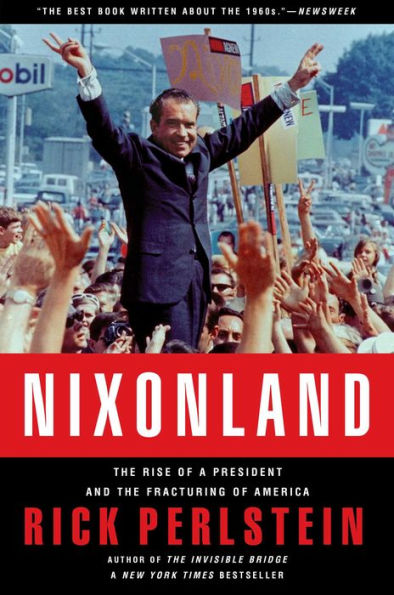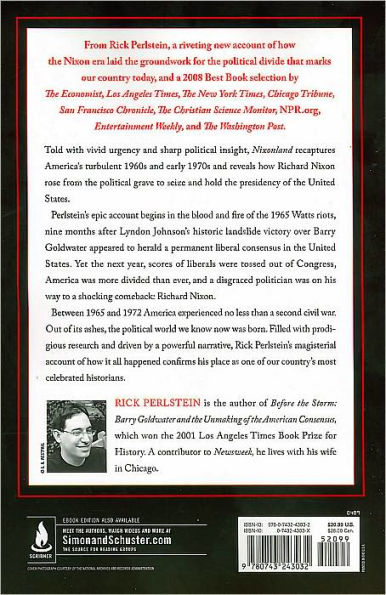Perlstein's epic account begins in the blood and fire of the 1965 Watts riots, nine months after Lyndon Johnson's historic landslide victory over Barry Goldwater appeared to herald a permanent liberal consensus in the United States. Yet the next year, scores of liberals were tossed out of Congress, America was more divided than ever, and a disgraced politician was on his way to a shocking comeback: Richard Nixon.
Between 1965 and 1972, America experienced no less than a second civil war. Out of its ashes, the political world we know now was born. It was the era not only of Nixon, Johnson, Spiro Agnew, Hubert H. Humphrey, George McGovern, Richard J. Daley, and George Wallace but Abbie Hoffman, Ronald Reagan, Angela Davis, Ted Kennedy, Charles Manson, John Lindsay, and Jane Fonda. There are tantalizing glimpses of Jimmy Carter, George H. W. Bush, Jesse Jackson, John Kerry, and even of two ambitious young men named Karl Rove and William Clinton -- and a not so ambitious young man named George W. Bush.
Cataclysms tell the story of Nixonland:
-Angry blacks burning down their neighborhoods in cities across the land as white suburbanites defend home and hearth with shotguns
-The student insurgency over the Vietnam War, the assassinations of Robert F. Kennedy and Martin Luther King, and the riots at the 1968 Democratic National Convention
-The fissuring of the Democratic Party into warring factions manipulated by the “dirty tricks” of Nixon and his Committee to Re-Elect the President
-Richard Nixon pledging a new dawn of national unity, governing more divisively than any president before him, then directing a criminal conspiracy, the Watergate cover-up, from the Oval Office
Then, in November 1972, Nixon, harvesting the bitterness and resentment born of America's turmoil, was reelected in a landslide even bigger than Johnson's 1964 victory, not only setting the stage for his dramatic 1974 resignation but defining the terms of the ideological divide that characterizes America today.
Filled with prodigious research and driven by a powerful narrative, Rick Perlstein's magisterial account of how America divided confirms his place as one of our country's most celebrated historians.
Perlstein's epic account begins in the blood and fire of the 1965 Watts riots, nine months after Lyndon Johnson's historic landslide victory over Barry Goldwater appeared to herald a permanent liberal consensus in the United States. Yet the next year, scores of liberals were tossed out of Congress, America was more divided than ever, and a disgraced politician was on his way to a shocking comeback: Richard Nixon.
Between 1965 and 1972, America experienced no less than a second civil war. Out of its ashes, the political world we know now was born. It was the era not only of Nixon, Johnson, Spiro Agnew, Hubert H. Humphrey, George McGovern, Richard J. Daley, and George Wallace but Abbie Hoffman, Ronald Reagan, Angela Davis, Ted Kennedy, Charles Manson, John Lindsay, and Jane Fonda. There are tantalizing glimpses of Jimmy Carter, George H. W. Bush, Jesse Jackson, John Kerry, and even of two ambitious young men named Karl Rove and William Clinton -- and a not so ambitious young man named George W. Bush.
Cataclysms tell the story of Nixonland:
-Angry blacks burning down their neighborhoods in cities across the land as white suburbanites defend home and hearth with shotguns
-The student insurgency over the Vietnam War, the assassinations of Robert F. Kennedy and Martin Luther King, and the riots at the 1968 Democratic National Convention
-The fissuring of the Democratic Party into warring factions manipulated by the “dirty tricks” of Nixon and his Committee to Re-Elect the President
-Richard Nixon pledging a new dawn of national unity, governing more divisively than any president before him, then directing a criminal conspiracy, the Watergate cover-up, from the Oval Office
Then, in November 1972, Nixon, harvesting the bitterness and resentment born of America's turmoil, was reelected in a landslide even bigger than Johnson's 1964 victory, not only setting the stage for his dramatic 1974 resignation but defining the terms of the ideological divide that characterizes America today.
Filled with prodigious research and driven by a powerful narrative, Rick Perlstein's magisterial account of how America divided confirms his place as one of our country's most celebrated historians.

Nixonland: The Rise of a President and the Fracturing of America
896
Nixonland: The Rise of a President and the Fracturing of America
896Paperback(Reprint)

Customer Reviews
Explore More Items
Pulitzer Prize-winning author Ron Chernow presents a landmark biography of Alexander
“Eminently readable but thick with import . . . Grant hits like a Mack truck of
With the same breadth of vision and narrative élan he brought to
With his previous books The House of Morgan, which won the National Book Award, and the critically acclaimed The Warburgs, Ron Chernow has proved himself a first-rate biographer as well as
Quotes captures your subconscious mind, which forms 90% of your total mind. The subconscious mind is the creative mind. So, when it is frequently filled with positive commands it will bring an
Winner of
One of the great classics on democracy,
Weaving together information from long-forgotten diaries and declassified Secret Service documents, journalist and historian Robert Klara exposes the private tensions and conflicts of a journey long
A vivid, dramatic, and authoritative account of perhaps the most influential family in Italian history: the Medici.
A dazzling history of the modest family that rose to become one of the most
Will we ever know the truth about the Kennedy



